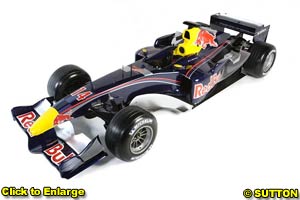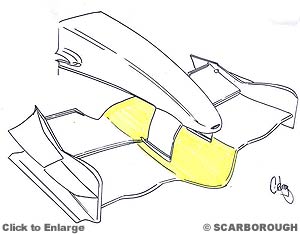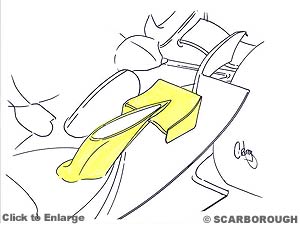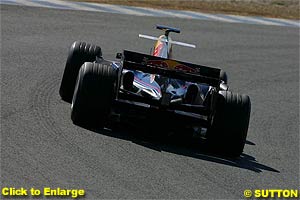
Atlas F1 Technical Writer
Without much flair, Red Bull Racing rolled out the first Formula One car under their name and on first appearence, the RB1 seems quite similar to its Jaguar predecessor, the R5. Still, there are some interesting and unique details on the car, and Atlas F1's technical writer Craig Scarborough offers a preliminary analysis of the blue and silver machine
The R5 lacked pace and reliability, placing it towards the rear of the mid field. It was designed to eradicate the failings of its predecessor, yet while it better managed the tyres, the car lost its qualifying pace. Its offspring, the RB1, was rolled out earlier this week without a launch or any great fanfare, and based on first impression alone, the car looks very similar to the R5 – although it does have some interesting details.
Starting at the front, Red Bull have been aggressive and gone for a front wing with a long chord dipped centre section very similar to BAR's solution. This hangs from a barely droops nosecone via long drop plates. The wing's endplates adopt a familiar looking shape with a stepped footplate.
Furthermore, the lower wishbones are of different cross sections either side of the bargeboards, being deeper outboard than inboard. And, despite the major changes to the flow off the front wing, Red Bull have retained their distinctive triangular brake ducts.
To react to the differing flow off the front wing, the bargeboards are new, using a larger and smaller vane each side - the larger board adopting Ferrari's Jagged footplate and Renault's axe head, albeit in a more subtle form. These boards sweep back to almost unchanged sidepod fronts, not adopting any form of undercut.
The chimneys work in conjunction with winglets so Red Bull have taken the logical progression to mount the pair together. As a result, the load from the winglet passes through the chimney and not via its own mounting, highlighting their interaction between cooling and downforce. With the now simpler cooling treatment, the exhaust fairing can be seen to form the rear trailing edge of the sidepod. Also, carried over from last year's car, the flip uses a vertical strut for support, splitting into three elements at it slower extremity.
The rear wing is augmented by a mid wing, while the flip ups provide potential mounting for a shelf wing. As for the rear wing itself, it adopts large endplates loading the beam directly and not via a strut. To reduce drag the main plane and flap are slightly curved at their outer edges. Below, the lower beam sweeps forward to influence the diffuser. The diffuser uses a collar like detached gurney above the outer channels to regain the pressure difference lost by the lower tunnels, a design used previously by Arrows.
 Five years after their metamorphosis from Stewart Grand Prix to Jaguar Racing, the Milton-Keynes based team have emerged from the 2004 winter as Red Bull Racing. But ownership and names aside, the 2005 car bears a strong heritage to its predecessors, and, since 2004 was not a strong season for the then-named Jaguar team, this evolution does not necessary bode well for the RB1.
Five years after their metamorphosis from Stewart Grand Prix to Jaguar Racing, the Milton-Keynes based team have emerged from the 2004 winter as Red Bull Racing. But ownership and names aside, the 2005 car bears a strong heritage to its predecessors, and, since 2004 was not a strong season for the then-named Jaguar team, this evolution does not necessary bode well for the RB1.
 One of the effects of the raised front wing is where the flow trailing the wing goes. Being higher, the flow tends to travel upwards over the front suspension and over the sidepods - the latter is detrimental to rear wing performance. To counter this, most teams shape their front suspension to straighten the flow to prevent the unwanted up-wash. Red Bull have gone a step further than most and made the fairing that covers the steering arms much deeper, now extending far forward of the join between monocoque and nose cone.
One of the effects of the raised front wing is where the flow trailing the wing goes. Being higher, the flow tends to travel upwards over the front suspension and over the sidepods - the latter is detrimental to rear wing performance. To counter this, most teams shape their front suspension to straighten the flow to prevent the unwanted up-wash. Red Bull have gone a step further than most and made the fairing that covers the steering arms much deeper, now extending far forward of the join between monocoque and nose cone.
 Then the sidepods are quite different to the past generations of Jaguar, adopting chimneys over the flip up/duct arrangement. This narrower and neater layout is more flattering and one that aerodynamicist Ben Agathangelou was hesitant to adopt last year until the detail of its aerodynamics were understood.
Then the sidepods are quite different to the past generations of Jaguar, adopting chimneys over the flip up/duct arrangement. This narrower and neater layout is more flattering and one that aerodynamicist Ben Agathangelou was hesitant to adopt last year until the detail of its aerodynamics were understood.
 Mechanically, so far the car appears similar - repeating the recent use of a seven speed gearbox and a rear suspension arrangement, using coiled springs over the more common torsion bars. In this respect, Red Bull are unique in F1. The gearbox mates to the new TJ2005 Cosworth engine - again a development of the 2004 CR6 90-degree engine. Electronic management of all these systems continues to be maintained by Pi Research.
Mechanically, so far the car appears similar - repeating the recent use of a seven speed gearbox and a rear suspension arrangement, using coiled springs over the more common torsion bars. In this respect, Red Bull are unique in F1. The gearbox mates to the new TJ2005 Cosworth engine - again a development of the 2004 CR6 90-degree engine. Electronic management of all these systems continues to be maintained by Pi Research.
|
Contact the Author Contact the Editor |
Please Contact Us for permission to republish this or any other material from Atlas F1.
|
Volume 11, Issue 6
Articles
Technical Analysis: Ferrari F2004M
Technical Analysis: Red Bull RB1
2005 SuperStats: Winter Testing
The Fuel Stop
Regular Columns
The F1 Trivia Quiz
Bookworm Critique
On the Road
The Weekly Grapevine
> Homepage |